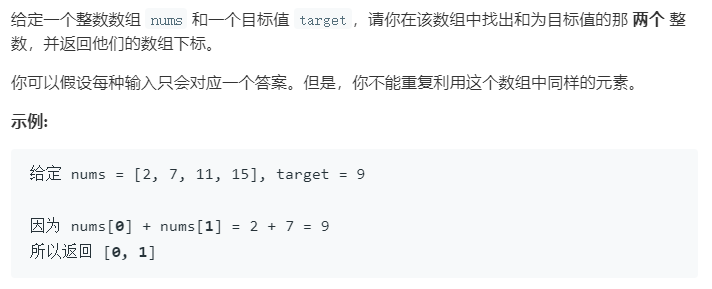两数之和(难度:简单)
 1578808347100
1578808347100
方法一:暴力法
遍历每个元素 x,并查找是否存在一个值与 target -
x相等的目标元素。
1
2
3
4
5
6
7
8
9
10
11
12
13
| class Solution {
public int[] twoSum(int[] nums, int target) {
for (int i = 0; i < nums.length; i++) {
for (int j = i + 1; j < nums.length; j++) {
if (nums[j] == target - nums[i]) {
return new int[] { i, j };
}
}
}
throw new IllegalArgumentException("No two sum solution");
}
}
|
复杂度
时间复杂度:O(n^2)
空间复杂度:O(1)
方法二:两遍哈希表
为了对运行时间复杂度进行优化,我们需要一种更有效的方法来检查数组中是否存在目标元素。如果存在,我们需要找出它的索引。保持数组中的每个元素与其索引相互对应的最好方法是什么?哈希表。
通过以空间换取速度的方式,我们可以将查找时间从 O(n)降低到
O(1)。哈希表正是为此目的而构建的,它支持以
近似恒定的时间进行快速查找。我用“近似”来描述,是因为一旦出现冲突,查找用时可能会退化到
O(n)。但只要你仔细地挑选哈希函数,在哈希表中进行查找的用时应当被摊销为
O(1)。
使用两次迭代。在第一次迭代中,我们将每个元素的值和它的索引添加到表中。然后,在第二次迭代中,我们将检查每个元素所对应的目标元素(target
- nums[i])是否存在于表中。注意,该目标元素不能是
nums[i]本身!
1
2
3
4
5
6
7
8
9
10
11
12
13
14
15
16
| class Solution {
public int[] twoSum(int[] nums, int target) {
Map<Integer, Integer> map = new HashMap<>();
for (int i = 0; i < nums.length; i++) {
map.put(nums[i], i);
}
for (int i = 0; i < nums.length; i++) {
int complement = target - nums[i];
if (map.containsKey(complement) && map.get(complement) != i) {
return new int[] { i, map.get(complement) };
}
}
throw new IllegalArgumentException("No two sum solution");
}
}
|
复杂度
时间复杂度:O(n),遍历两次,由于哈希表将查找时间缩短到 O(1)
,所以时间复杂度为 O(n)。
空间复杂度:O(n),所需的额外空间取决于哈希表中存储的元素数量。
方法三:一遍哈希表
在进行迭代并将元素插入到表中的同时,回过头来检查表中是否已经存在当前元素所对应的目标元素。如果它存在,那我们已经找到了对应解,并立即将其返回。
1
2
3
4
5
6
7
8
9
10
11
12
13
14
| class Solution {
public int[] twoSum(int[] nums, int target) {
Map<Integer, Integer> map = new HashMap<>();
for(int i = 0; i < nums.length; i++){
if(map.containsKey(target - nums[i]))
return new int[] {map.get(target - nums[i]), i};
map.put(nums[i],i);
}
return new int[] {};
}
}
|
复杂度
时间复杂度:O(n),只遍历一次。
空间复杂度:O(n)。
